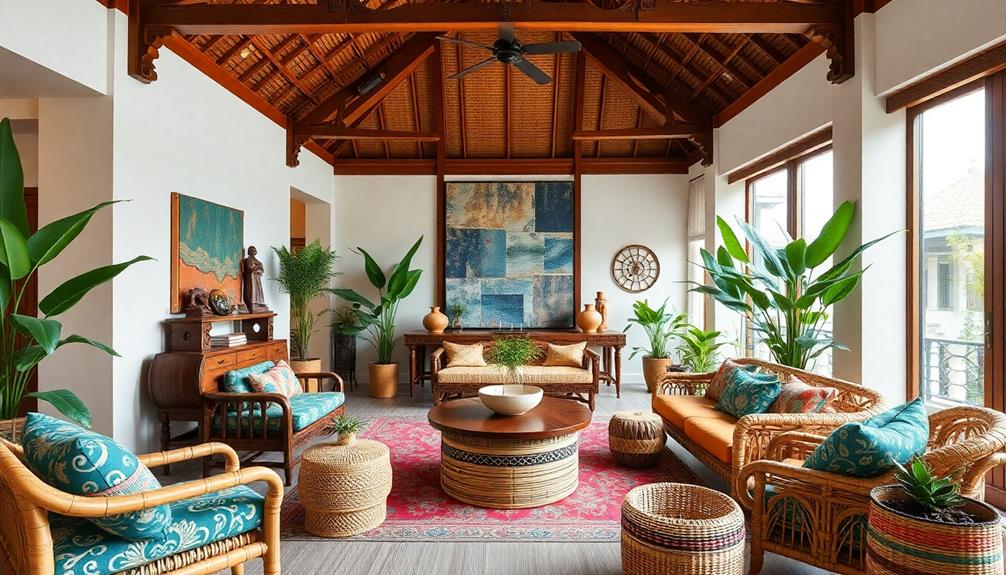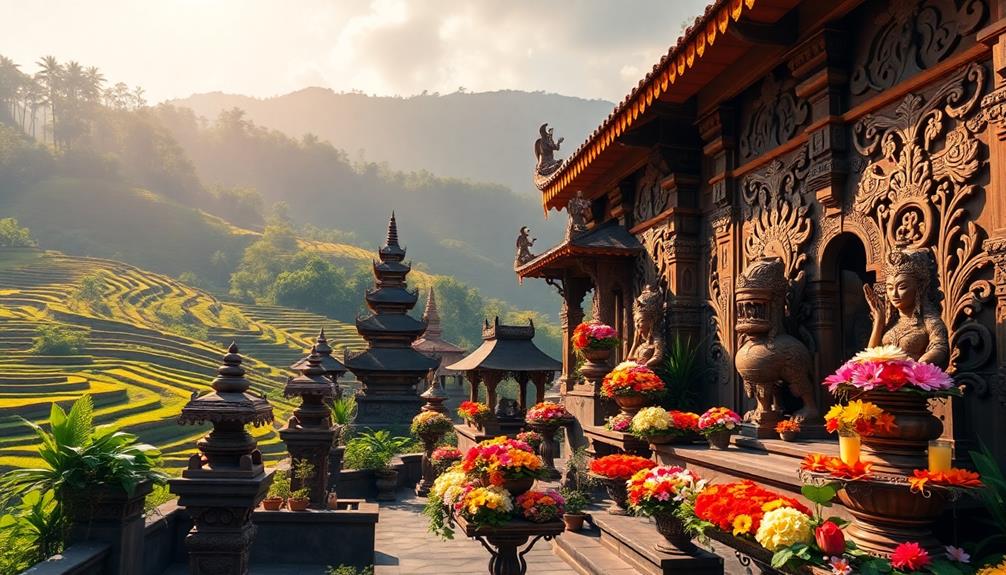You can embrace Indonesian heritage in your contemporary interiors by blending traditional elements with modern design. Incorporate indigenous architectural inspirations like open layouts and natural materials, emphasizing sustainability and community. Use historical temple aesthetics to create focal points that inspire conversation, while colonial architecture offers a unique fusion of styles. Focus on family-centric spaces that foster connection, balanced with private comfort areas for relaxation. Thoughtful spatial planning enhances airflow and views, making your home feel inviting. Discover how to bring these rich cultural narratives into your space for a truly unique ambiance that reflects your personal style.
Key Takeaways
- Incorporate indigenous architectural elements, like communal spaces and local materials, to celebrate cultural heritage and sustainability in modern designs.
- Blend historical temple aesthetics with contemporary interiors to enrich spaces with cultural significance and natural harmony.
- Utilize colonial architectural influences to create vibrant urban environments that reflect Indonesia's diverse cultural history.
- Emphasize open layouts and natural materials to enhance airflow, light, and connection to nature in residential spaces.
- Foster collaboration with homeowners to ensure designs resonate with personal values while honoring traditional Indonesian craftsmanship.
Indigenous Architectural Inspirations
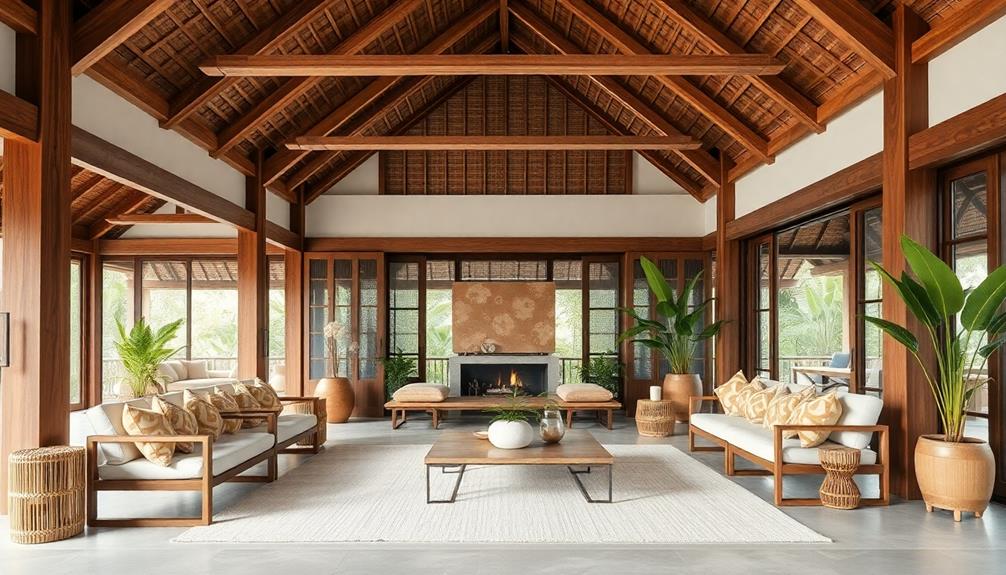
When you explore Indonesian heritage through architecture, you'll find a rich tapestry of indigenous inspirations that shape contemporary interiors. Indigenous structures like the Rumah Gadang and Torajan Tongkonan exemplify how cultural richness and environmental adaptability come together in elevated designs.
These architectural wonders emphasize community, offering spaces for social gatherings while maintaining individual privacy. Additionally, the use of local materials such as wood and bamboo in these designs showcases a commitment to sustainability and environmental harmony, reflecting traditional Indonesian housing practices.
In Bali, contemporary interior design often draws from these local aesthetics, creating a harmonious blend of tradition and modernity. By incorporating traditional motifs and materials, designers enhance the narrative of Indonesian heritage within modern contexts. This approach not only preserves cultural elements but also revitalizes them, allowing you to appreciate Indonesia's diverse identity in your living spaces.
Moreover, the revival of indigenous architectural elements fosters sustainable living practices. By embracing these designs, you engage with the environment in a way that honors both the past and the future.
Ultimately, the integration of indigenous inspirations in interior design offers a unique opportunity to immerse yourself in the beauty and significance of Indonesian culture, ensuring that you live in spaces that resonate with history and community.
Historical Temple Aesthetics
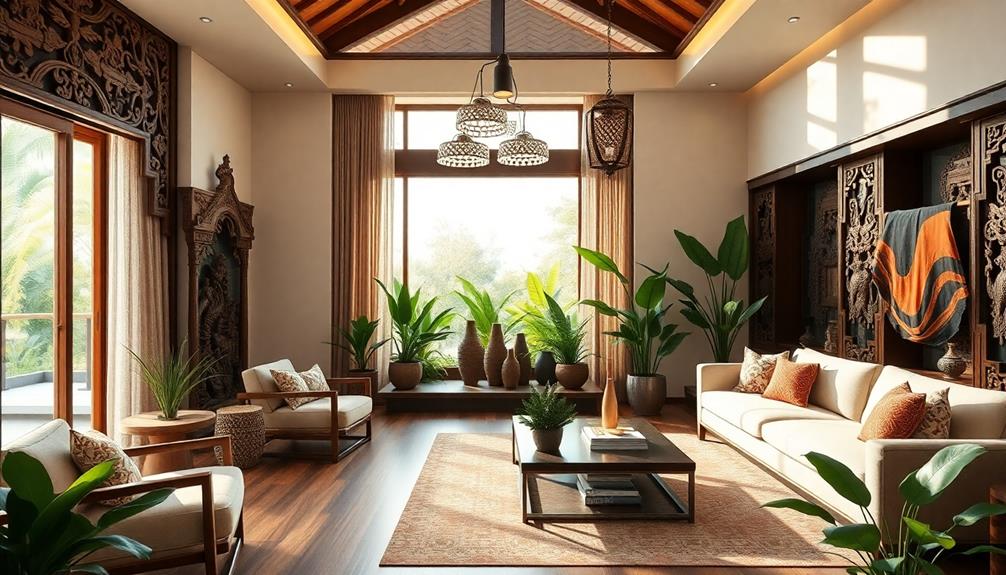
When you look at historical temples like Borobudur and Prambanan, you can see how their intricate designs inspire contemporary interiors.
The emphasis on blending indoor and outdoor environments, reminiscent of modern tropical aesthetics, can be incorporated into your home to enhance its connection to nature.
Incorporating elements from these sacred spaces adds cultural significance to your home while honoring Indonesia's architectural heritage.
Temple Design Inspiration
Drawing from the rich heritage of Indonesia's historical temples, contemporary interior design captures the essence of ancient aesthetics while addressing modern needs. Temples like Borobudur and Prambanan inspire you to create living spaces that reflect cultural heritage through their intricate carvings and architectural precision.
By embracing symmetrical layouts and terraced structures, you can infuse your interiors with a sense of balance and harmony reminiscent of these revered sites. Utilizing elements like vibrant colors and intricate patterns in your decor can further enhance the connection to Indonesian traditions.
Incorporating temple aesthetics often means using natural materials and intricate patterns, echoing the craftsmanship seen in traditional Indonesian architecture. This approach can make your living space not just visually stunning but also deeply connected to the cultural narrative of Indonesia.
Educational initiatives on ancient architectural techniques equip you with the knowledge to apply these temple design principles effectively. This understanding enhances the cultural depth of your modern spaces, allowing you to celebrate local identity while meeting contemporary needs.
Cultural Significance in Interiors
Incorporating elements from historical temple aesthetics into modern interiors not only enhances visual appeal but also imbues spaces with deeper cultural significance. When you're designing the living room—the heart of the house—consider drawing inspiration from the intricate designs of Indonesia's iconic temples like Borobudur and Prambanan.
These structures showcase exceptional craftsmanship and harmony, serving as a model for integrating cultural elements into your home. By embracing natural materials and open floor plans reminiscent of Balinese design characteristics, you can further enhance the connection to your surroundings.
Using precise stone carvings or structural designs reminiscent of these temples can create a focal point in your living room, inviting conversation and admiration. By doing so, you not only honor traditional artistry but also connect your space to Indonesia's rich architectural history. Such choices enrich the narrative of architectural evolution, making your home a representation of cultural appreciation.
Moreover, these historical aesthetics can attract curiosity and inspire deeper connections among family and friends, fostering a sense of community. As you embrace these elements, you'll find that your living room transforms into more than just a gathering space; it becomes a celebration of Indonesia's cultural heritage, bridging past and present in a meaningful way.
Preservation Through Modern Techniques
Today, preserving the intricate aesthetics of historical temples like Borobudur and Prambanan involves leveraging modern techniques that respect and adapt these designs for contemporary interiors.
By collaborating with architecture consulting firms, you can utilize advanced technology and historical research to maintain the unique features of these temples while integrating them into modern applications. This approach not only enhances the visual appeal of your space but also honors Indonesia's rich architectural heritage.
Incorporating natural materials like wood and stone, as seen in traditional Indonesian style home decor, further enriches the design and connects it to the cultural roots.
Engaging in educational initiatives surrounding ancient architectural techniques deepens your understanding of historical aesthetics, encouraging their thoughtful integration into your interior design.
You'll discover how blending traditional temple forms with modern design practices fosters cultural appreciation, creating environments that resonate with the past.
Incorporating elements inspired by these temples allows your contemporary interiors to reflect a narrative of cultural continuity.
Each design choice you make can bridge the gap between past and present, demonstrating an innovative way to celebrate Indonesia's architectural history.
Embrace these inspirations, and let your spaces tell stories that honor the legacy of historical temples while offering a fresh, modern twist.
Colonial Architecture Fusion

When you explore colonial architecture in Indonesia, you'll notice how Dutch influences blend seamlessly with local styles, creating enchanting urban landscapes.
This fusion reflects the diverse architectural styles that celebrate Indonesia's cultural heritage, showcasing the rich history of traditional Indonesian houses.
Historical Context and Influence
Indonesia's architectural landscape tells a compelling story of fusion, where Dutch colonial influences meld seamlessly with local design elements. As you explore cities like Jakarta and Bandung, you'll notice how this unique blend creates a vibrant tapestry of styles, particularly evident in tropical villa plans that emphasize open spaces and natural light.
Historical sites such as Kota Tua and Gedung Sate exemplify this architectural synergy, showcasing the marriage of colonial aesthetics with indigenous artistry.
The integration of these colonial remnants into modern design strategies not only preserves historical depth but also enhances the contemporary relevance of Indonesian interiors. When interior design companies incorporate colonial features, they guarantee that the narrative of Indonesia's architectural evolution remains a crucial part of the design conversation.
This preservation of colonial architecture serves as a cultural landmark, attracting both tourists and scholars alike, while educating the public about the complexities of Indonesia's architectural history.
You'll find that understanding this historical context enriches your appreciation for contemporary interiors, where every piece tells a story of the past while looking toward the future. Embracing this heritage adds layers to your design choices, making your space not just visually appealing but also deeply connected to Indonesia's rich history.
Design Elements and Techniques
Colonial architecture's fusion with indigenous design elements creates a rich palette for contemporary interiors, seamlessly blending functionality with aesthetic appeal. This integration is evident in various structures that showcase a unique architectural narrative, particularly in cities like Jakarta and Bandung.
You can incorporate these design elements to evoke a sense of grandeur while ensuring modern relevance. Additionally, the use of vibrant artistry and traditional artistry in decor can enhance the overall aesthetic, reflecting the rich cultural heritage of Indonesia.
Consider these three key aspects when designing your space:
- High Ceilings: These not only enhance airflow but also create an illusion of spaciousness, making your interiors feel more open and inviting.
- Wide Verandas: Incorporating verandas offers a connection between indoor and outdoor spaces, ideal for enjoying Indonesia's natural beauty while providing a shaded area for relaxation.
- Traditional Materials: Using local materials, such as teak wood and terracotta tiles, helps bridge the gap between the past and present, adding authenticity and warmth to your design.
Contemporary Relevance and Adaptation
The beauty of contemporary design lies in its ability to adapt and evolve while honoring historical influences. In Indonesia, Dutch colonial architecture serves as a striking example of this fusion. Regions like Jakarta and Bandung showcase buildings that blend European and local design elements, creating a rich historical narrative.
Take a stroll through the Kota Tua district in Jakarta, where preserved colonial structures act as cultural landmarks, reflecting the city's architectural journey over centuries. Many interior design firms in Bali, such as Mahallati Interiors, are known for their focus on blending natural elements with modern luxury, ensuring that these historical influences are seamlessly integrated into contemporary designs.
Similarly, Gedung Sate in Bandung exemplifies this harmonious blend, featuring intricate details that echo both colonial and indigenous styles.
Today, interior design firms are increasingly integrating these historical elements into modern spaces, creating environments that respect the past while meeting contemporary needs.
This adaptation isn't just about aesthetics; it fosters a deeper understanding of Indonesia's diverse cultural heritage. By weaving colonial architecture into modern design, you not only enhance the visual appeal of your space but also pay homage to the rich history that shapes it.
Embracing these elements allows you to create a unique atmosphere that celebrates the past while remaining relevant in today's world.
Sustainable Design Practices

Sustainable design practices are at the forefront of contemporary architecture in Indonesia, blending modern aesthetics with deep respect for local traditions.
Indonesian architects prioritize environmentally conscious methods that honor cultural values while minimizing ecological impact. This approach not only enhances the beauty of structures but also creates a healthier living environment for inhabitants.
Additionally, incorporating traditional elements, such as Indonesian decor masks, can further enrich the cultural narrative within these spaces.
To truly embrace sustainability, consider these key practices:
- Community Involvement: Engaging local residents in the design process fosters collective ownership and guarantees that projects meet the community's actual needs.
- Locally Sourced Materials: Utilizing local resources reduces transportation emissions and supports regional economies, making your project more sustainable and culturally relevant.
- Natural Ventilation and Lighting: Incorporating features that enhance airflow and daylighting improves energy efficiency and creates a more comfortable living space.
These practices not only align with Indonesia's sustainable development goals but also contribute to architectural aesthetics that reflect the rich heritage of the region.
Balinese Design Elements
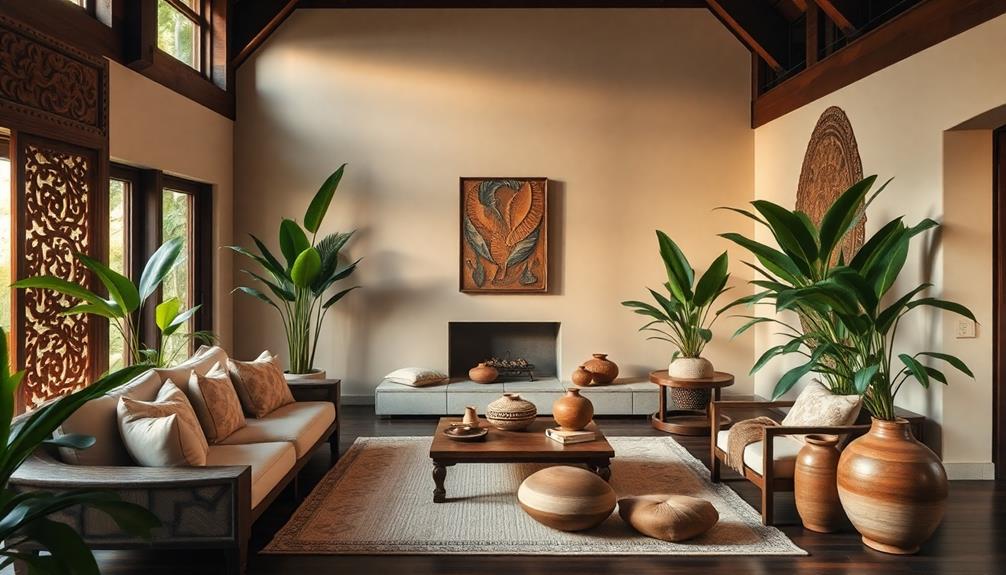
Embracing Balinese design elements can greatly enhance the beauty and cultural resonance of contemporary interiors. The intricate carvings and open pavilions typical of Balinese architecture create a seamless connection between indoor and outdoor spaces, promoting tranquility and balance. By utilizing natural materials like bamboo and stone, you reflect a deep respect for the environment and a commitment to sustainability.
Integrating water features, such as ponds and fountains, symbolizes purification and adds a serene aesthetic to your space. Decorative textiles and traditional artwork celebrate the island's rich artistic heritage, adding layers of cultural significance to your interiors.
Incorporating lush greenery and vibrant flora not only beautifies your environment but also improves air quality and promotes well-being.
Here's a quick overview of key Balinese design elements:
| Element | Description |
|---|---|
| Intricate Carvings | Adds artistic flair and cultural depth |
| Natural Materials | Promotes sustainability and environmental respect |
| Water Features | Enhances serenity and symbolizes purification |
| Lush Greenery | Improves air quality and promotes overall well-being |
Architectural Vision and Concept
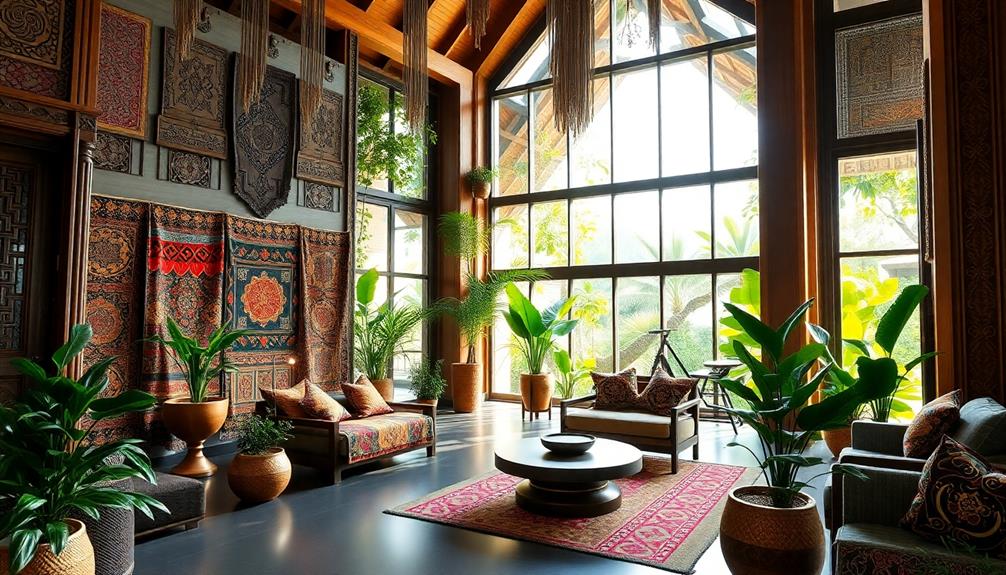
When you think about architectural vision, consider how blending traditional Indonesian elements with modern design can create a space that truly reflects your identity.
Collaborating with homeowners is key to understanding your preferences and lifestyle, ensuring the final outcome resonates with your values.
This unique approach not only honors heritage but also results in innovative architectural expressions that enhance your living environment.
Blending Tradition and Modernity
In the quest to create living spaces that resonate with both tradition and modernity, architects focus on seamlessly integrating traditional Indonesian elements—like intricate carvings and airy pavilions—with contemporary design principles.
This approach not only honors cultural heritage but also reflects your personal identity and lifestyle.
To achieve this blend, consider the following key aspects:
- Natural Materials: Using locally sourced materials pays homage to Indonesia's rich architectural history while promoting sustainability. It creates a connection between the past and present.
- Thoughtful Planning: Spaces are designed to maximize natural ventilation and light. Features such as courtyard gardens and rooftop greenery not only enhance the aesthetic but also respect traditional values of harmony with nature.
- Architectural Statement: The design process aims to craft a unique statement that serves as a canvas for your lifestyle and values, bridging the gap between historical craftsmanship and modern living needs.
Homeowner Collaboration Process
The homeowner collaboration process is essential for crafting a design that truly reflects your lifestyle and preferences. It begins with in-depth discussions, allowing you to express your design inclinations and cultural values. This dialogue helps the architect understand your vision, ensuring the final outcome resonates with your unique identity.
Integrating traditional elements with modern designs is a focal point of this collaboration. As you share your artistic tastes, you'll find that the selection of materials and finishes celebrates both your heritage and contemporary living.
The architectural vision prioritizes privacy and functionality, tailoring designs for family-centric spaces while promoting natural light and ventilation.
Throughout the process, feedback loops play a vital role. You'll have the opportunity to review concepts and suggest adjustments, ensuring the design evolves to match your expectations. This iterative approach not only fine-tunes the aesthetic but also harmonizes it with the surrounding environment.
Unique Architectural Expressions
Blending traditional Indonesian architectural elements with modern design creates unique expressions that resonate with your vision.
This harmonious fusion reflects not only your personal preferences but also the rich cultural heritage of Indonesia. Engaging in extensive discussions during the design process guarantees that your lifestyle is seamlessly integrated into the architectural vision.
Here are three key aspects to reflect upon when embracing unique architectural expressions:
- Inspiration from Tradition: Structures like the Rumah Gadang and Torajan Tongkonan provide a foundation for contemporary designs, showcasing elevated forms that adapt to the local climate.
- Sustainable Practices: Using natural materials and environmentally friendly methods honors traditional values while addressing modern ecological concerns, creating spaces that are both beautiful and responsible.
- Thoughtful Spatial Planning: Prioritizing natural light, ventilation, and privacy leads to harmonious interiors that engage with nature, enhancing your living experience and celebrating Indonesia's cultural richness.
Spatial Planning Strategies
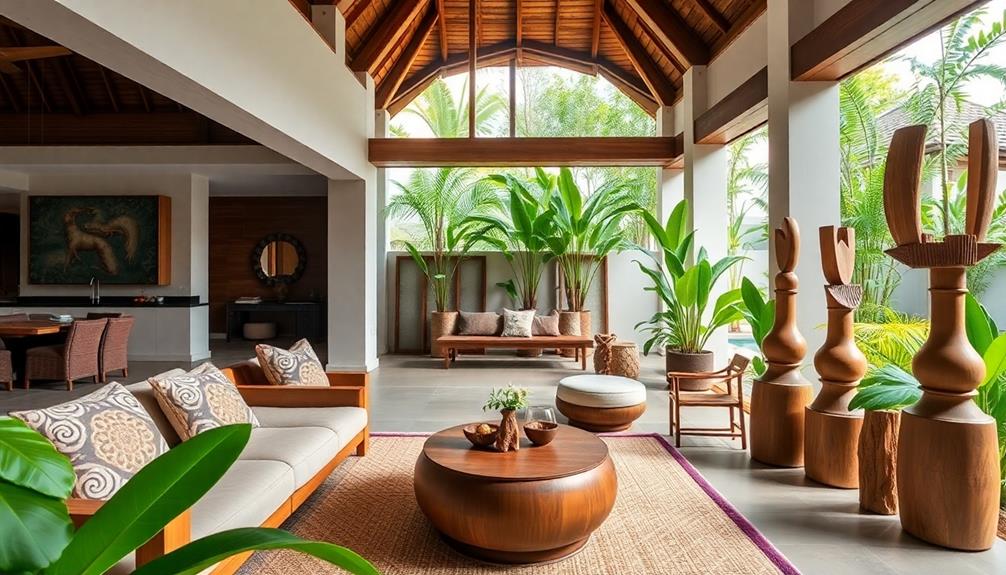
Open layouts dominate spatial planning strategies in contemporary Indonesian interiors, enhancing natural ventilation and creating a sense of flow between communal and private spaces. This approach reflects traditional architectural principles while adapting to modern needs. By integrating courtyards, designers separate communal areas from private ones, improving air circulation and allowing natural light to filter in.
Strategically positioned windows and openings maximize views of lush gardens, connecting indoor and outdoor elements. These designs draw inspiration from the local climate and cultural aesthetics, creating harmony with nature. Additionally, incorporating natural materials and textures not only pays homage to Indonesian heritage but also promotes sustainable living practices.
Here's a quick overview of key spatial planning features:
| Feature | Benefit | Cultural Significance |
|---|---|---|
| Open Layouts | Enhances flow and ventilation | Reflects communal values |
| Courtyards | Improves light and air circulation | Connects to nature |
| Natural Materials | Supports sustainability | Celebrates local craftsmanship |
Family-Centric Spaces
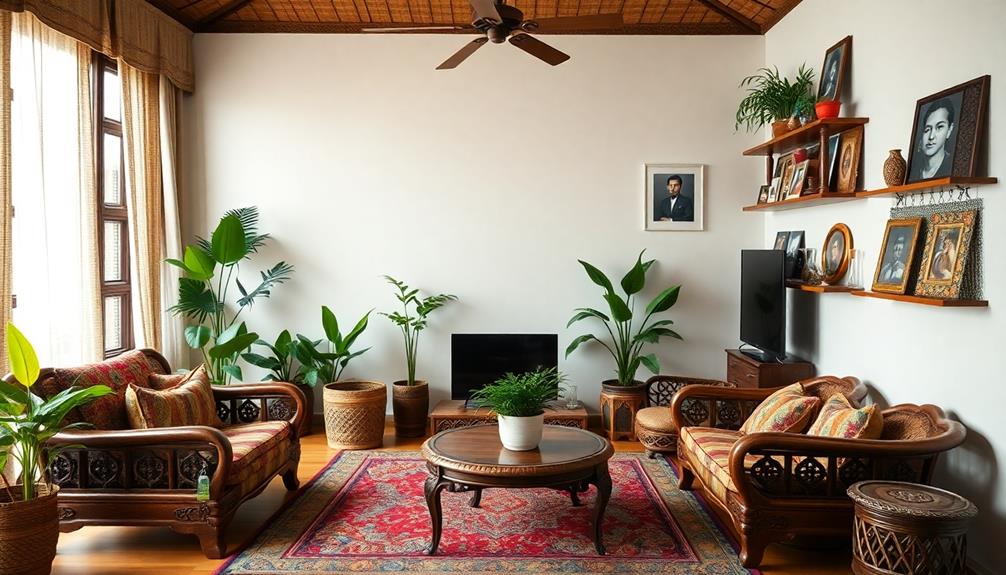
While prioritizing family interactions, contemporary Indonesian interiors create spaces that foster connection and togetherness. The heart of your home often lies in communal areas, especially dining rooms designed for shared meals and gatherings.
Open connections between living and dining areas enhance interaction, while distinct ceiling designs maintain unique atmospheres within these spaces.
To create a family-centric environment, consider incorporating the following elements:
- Antique and Modern Furnishings: Blend pieces that reflect your heritage and personal history, adding a unique aesthetic that promotes belonging.
- Bay Windows: Use these features to provide extra seating and garden views, encouraging family members to engage with nature and each other.
- Thoughtful Layouts: Design your home to emphasize privacy for individual family members while maintaining a strong sense of community through well-planned communal spaces.
Private Comfort Areas

Creating private comfort areas in your home is essential for fostering relaxation and personal reflection. Master bedrooms should be strategically positioned to capture morning sunlight, creating a warm and inviting atmosphere that enhances your comfort.
By incorporating glass bay windows, you can enjoy serene views of courtyard gardens, allowing nature to seep into your personal space.
Consider placing bathtubs by large windows to maximize natural light and ventilation. This thoughtful design not only encourages relaxation but also promotes wellness, making your bathing experience a rejuvenating ritual.
Private lounges in your home can serve as tranquil spots for reflection and observation, blending comfort with the peaceful ambiance you crave.
Emphasizing natural lighting and air circulation in these private spaces supports sustainability and enhances your overall living quality.
By designing areas that prioritize comfort and connection to nature, you cultivate a sanctuary that nurtures your well-being.
Whether it's a cozy reading nook or a sunlit bedroom, these private comfort zones invite you to unwind and recharge, allowing you to embrace the serene aspects of your environment while reflecting on your personal journey.
Cultural Heritage Integration
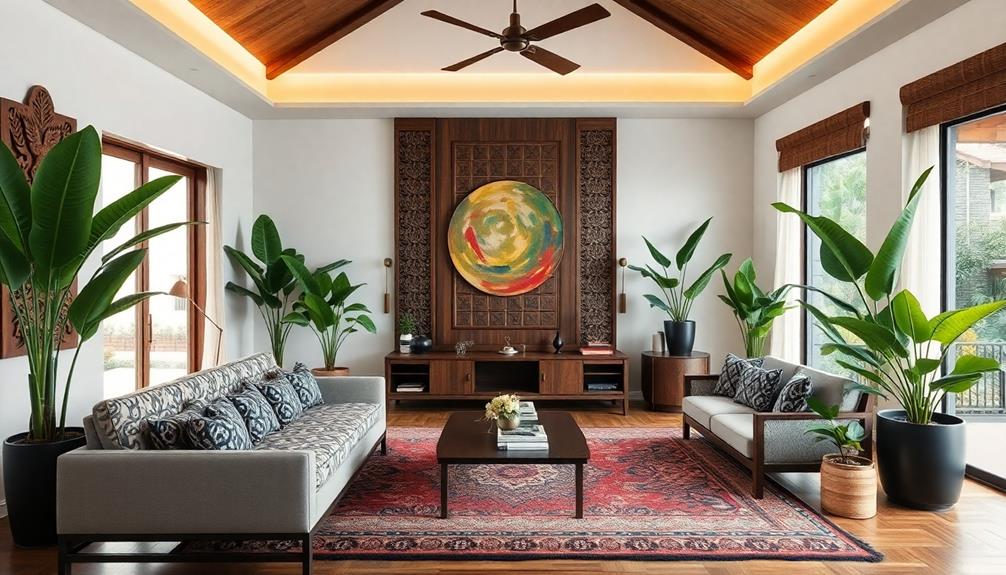
Cultural heritage integration breathes life into contemporary interiors, transforming spaces into narratives of history and identity.
By blending traditional elements with modern aesthetics, you create environments that not only reflect personal style but also celebrate Indonesia's rich heritage.
To effectively integrate cultural heritage into your interior design, consider these three key approaches:
1. Incorporate Indigenous Architecture: Elements from structures like Rumah Gadang and Torajan Tongkonan can enhance functionality while honoring climatic adaptations.
Use their shapes or materials in your designs.
2. Embrace Traditional Aesthetics: Balinese design, with its intricate carvings and open pavilions, adds an artistic touch to modern spaces.
Infuse these details into furniture or wall art to foster appreciation.
3. Merge Historical Influences: Referencing colonial architecture, such as Gedung Sate, allows you to weave local and Dutch styles together.
This fusion can create a compelling narrative in your interiors.
Frequently Asked Questions
What Are Key Indonesian Materials for Modern Interior Design?
When considering key Indonesian materials for modern interior design, you'll find bamboo, teak wood, rattan, and batik fabrics essential. These elements offer a unique blend of sustainability, durability, and cultural richness, enhancing your space beautifully.
How Can I Incorporate Local Art Into My Home?
You can incorporate local art into your home by displaying unique pieces that reflect your culture. Hang paintings, showcase sculptures, or use textiles to create a vibrant atmosphere, enhancing your space with personal touches.
What Traditional Patterns Are Popular in Contemporary Interiors?
You'll find traditional patterns like geometric motifs, floral designs, and batik prints popular in contemporary interiors. These elements add depth and character, blending seamlessly with modern aesthetics while honoring cultural roots in your space.
How Do I Source Authentic Indonesian Textiles?
To find authentic Indonesian textiles, immerse yourself in local markets, where vibrant colors dance in the light. Explore online platforms specializing in artisanal goods, and connect with artisans directly for unique pieces that tell their stories.
Are There Specific Color Palettes Associated With Indonesian Heritage?
Yes, there are specific color palettes tied to Indonesian heritage. You'll often find rich earth tones, vibrant reds, deep blues, and lush greens that reflect nature, culture, and traditional art forms throughout the archipelago.
Conclusion
As you explore the beauty of Indonesian heritage in modern interiors, you're not just decorating; you're weaving a story rich with history, culture, and sustainability. Imagine the fusion of ancient temple aesthetics with contemporary design, creating spaces that breathe life and tradition. What if your home could reflect a legacy that transcends time? By embracing these elements, you're not just enhancing your space—you're inviting an enchanting narrative into your everyday life. Are you ready to begin?
